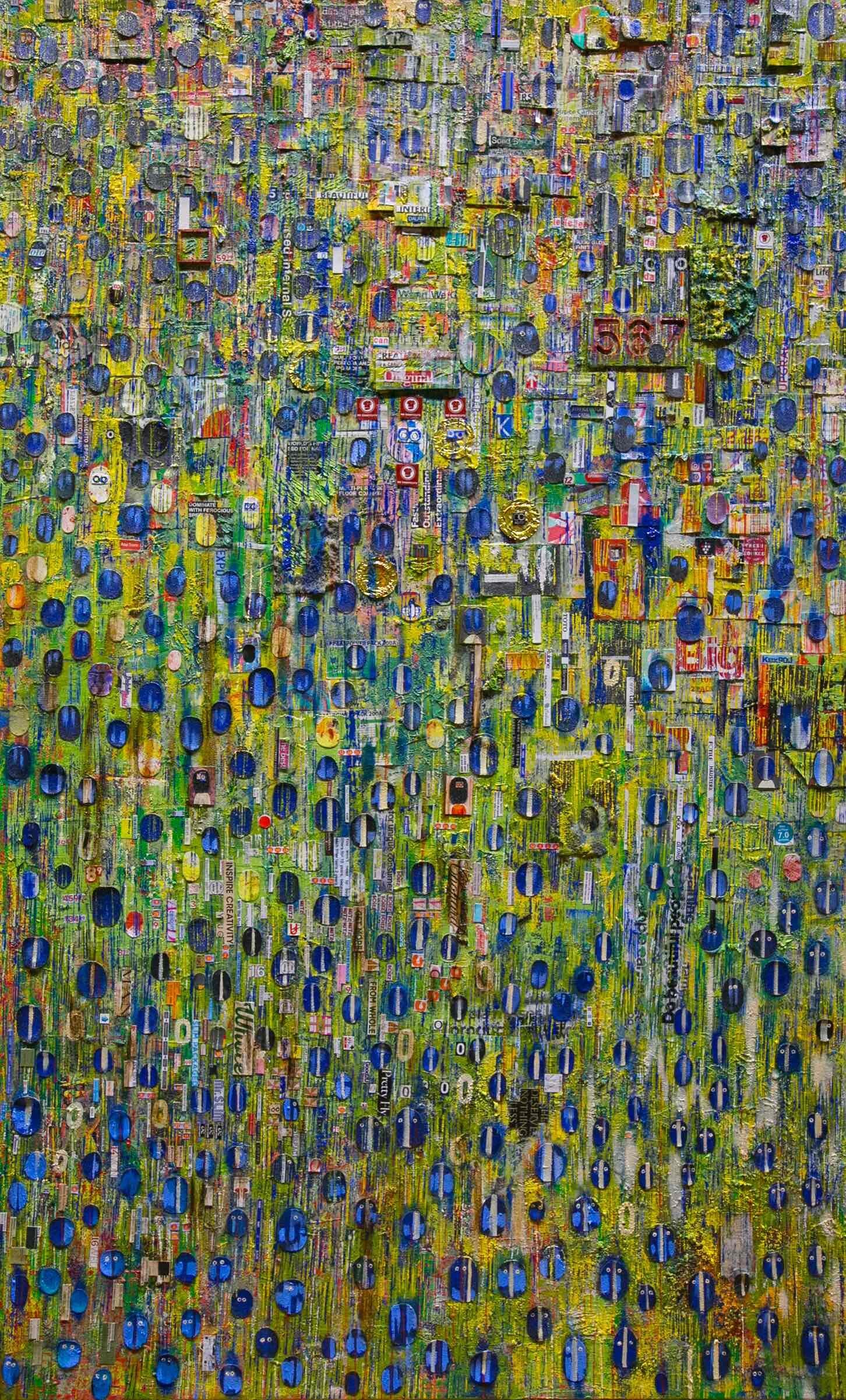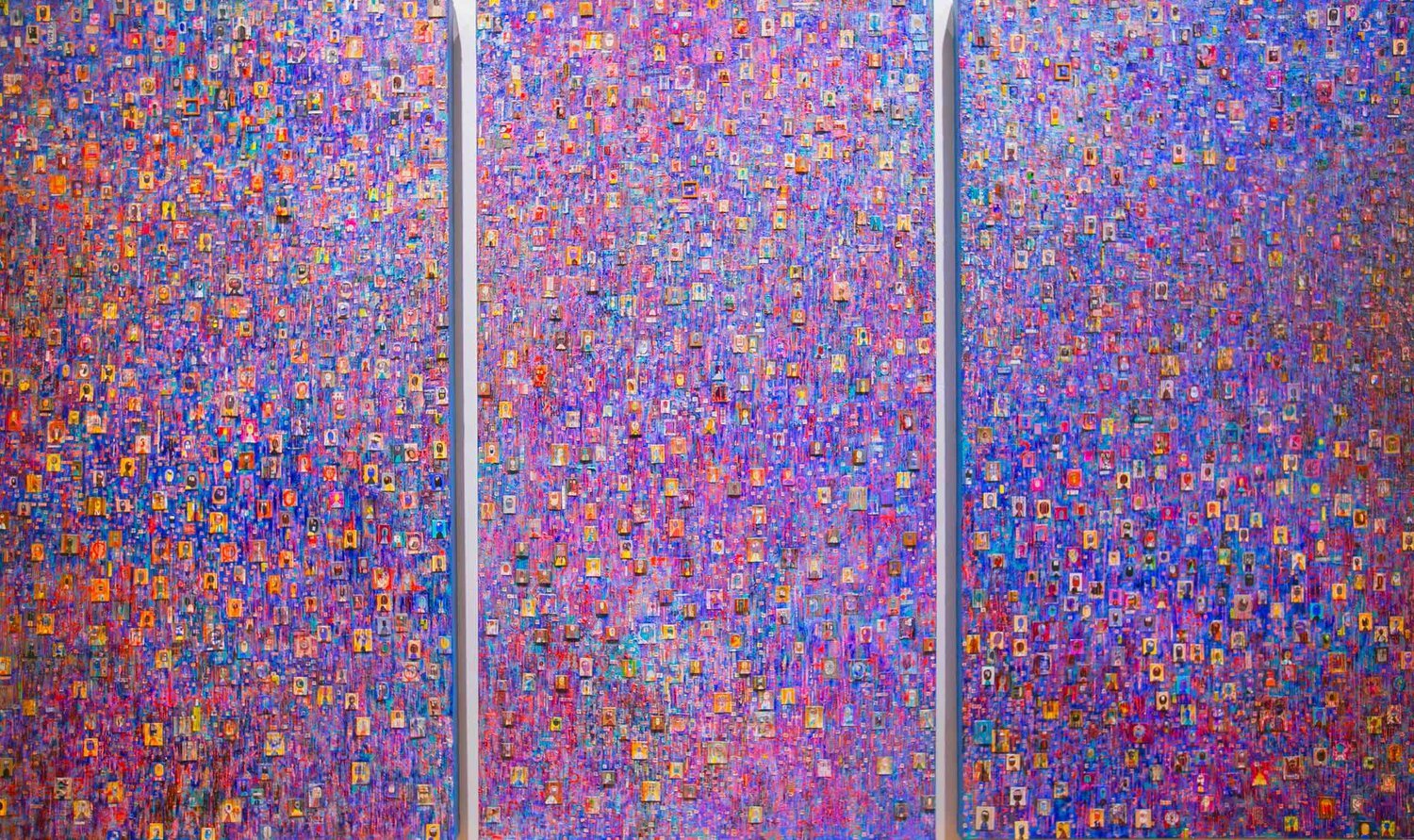Choy Chun Wei at Wei-Ling Gallery
Encountering Mass Man
By Celina Loh
We may think we know Choy Chun Wei’s works — feel that with his use of printed materials from our consumer era that we understand them — and take pride in our ability to access his hybrid world that is based on the fourfold schema of artist and object, the media and the mind. As ‘Encountering Mass Man’ demonstrates, there is much more to the title than meets the eye. The suite of eight vibrantly coloured works mounted onto the wall will ensnare you, as do the far from innocent fragments of slick advertising prints which transport you into a discomforting world; a place of captivation where optically, nothing is quite what it first seems to be. As Choy elucidates about the title, “As delightful as it is that we are connected to one another through virtual communication in this lockdown, our meetings are nevertheless still projections. There is a longing for tangible relationships in the resistance and boundaries, and how that is important to us.” ‘Encountering Mass Man’ suggests a paradox and expresses a balancing act that nudges us to search ourselves in a turbulent, liquid environment.
Choy’s compositions of abstracted fields are placed across the room like storyboards, prompting us to move between and around them as we attempt to build our own narratives. One could first view the paintings from a distance, taking in the dramatic sweep of colours and the corresponding relationship the pieces have with one another. Then, later entering into the space and moving through it, experiencing a shuffling sequence of colours which results in stopping to scrutinise the texture of Choy’s mark-making on the canvas, or ponder why he has decided to include more ellipses than his distinctive quadrilaterals.
While the artist’s works since 2001 have explicitly invited us to be critical of commodification in the rapid pace of urbanism, this series extends beyond that discourse with delicate nuances which mark a significant progression in his artistic career. Speaking with Choy about the ellipses, he explained, “I’ve always been fascinated by them visually. What I find interesting is that these rounded shapes echo our ears and kidneys, thumb and head. The forms seem to almost mirror one another through their oval shapes; it is symbolic in that it reflects more on being human and how the current condition has affected me, the world, and our movement throughout.”
As more existing technologies are stacked onto each other, leading to a dependency on online connectivity, it has been easy to believe that our freedom of expression and self are best played out on technological platforms. There is an intoxicating feeling of gratification that goes hand in hand with instant response, and yet there exists a sharp increase in anxiety and uncertainty when portraying ourselves to the world beyond our screen windows. To quote philosopher Martin Heidegger in his magnum opus ‘Being and Time’ (1927), “everyone is the other and no one is himself.’1 Heidegger’s understanding of our being is pertinent to Encountering Mass Man.
Choy Chun Wei, ‘Grappling’, 2020-2021, mixed media on jute canvas, 168cm x 107cm. Image courtesy of the artist.
‘Grappling’ (2020-21) offers us an insight into the paradox graphically: abstract portraits of ovals, some completed with typed symbols, cut and pasted onto a collaged background of everyday articles and words such as “attractive choices”, “bigger”, and “instant”. The scale of the work requires that we come close, peering into the sanitised and anonymous figures who seem dehumanised; individuality is expendable, and identity is quantifiable only in terms of ownership and exchange. Their eyes of digits ‘O’ or ‘0’ are meticulously cut out and mounted onto the portraits that recall distinct emotions — puzzled, focused, anxious — within the media where there’s always something new, always a new trend, a new person to follow that you need to grapple with, to the point that you get exhausted. The format is fitting for the materials Choy is working with: his collection of photo slide shells which he had used to present his portfolio in the 2000s, snippets of mass-produced publishing, textures of paint and thumb prints. If we are used to thinking that digital portrayals will disclose the truth of their subjects to us, in Choy’s hands, this promise of legibility is interrupted. And to look through the tangible windows created by photo slide shells which invade the work with nostalgia: when was the last time we really kept information and memories we once stored in our brain, rather than simply turning to the technology at the palm of our hand?
Choy Chun Wei, ‘Volatility’, 2020-2021, mixed media on jute canvas, 198cm x 107cm. Image courtesy of the artist.
In the metadata of Choy’s work is a dialogue on technocapitalism; in this case, our complacency towards it. The Hungarian Bauhaus artist László Moholy-Nagy, when adding finishing touches to his window displays for Simpson’s department store in London in 1936, expressed that ‘the impact has to come from the familiar object presented in an unfamiliar way.’2 Choy’s painting ‘Volatility’ (2020-2021) in a palette of red, yellow and blue makes this visible to us; topsy-turvy portraits and overlapping arrow symbols pointing to divergent paths that visually disrupts the sense of order, compels the viewer to keep looking, searching for a way to possess the work. Just as Choy’s recontextualised tags of publicity materials denote consumerism, his arrow symbols against textured vertical lines allude to the back-forward buttons in algorithmic systems through form rather than in material. Volatile, our lives extend beyond these navigational pointers which are “direct and easily controlled.” Our innovation, outfit of the day, or last fancy meal fuels the algorithm that offers space to personalised marketing. While the index of internet icons paves the way for bespoke advertising, it is also a billowing unpredictability that threatens our freedom in the capitalist systems of control. As Choy's stark yellow arrows give the impression of a cautionary sign, the sentimental tone that wafts across his oeuvre overlays them with hope and strength. Examining the legacies of modernist movements, particularly Bauhaus and Constructivism, Choy has developed his own collection of pictorial codes. The interdependent parts of his carefully constructed compositions cannot be segregated but are held in gracefully balanced tension by the treatment of the painting as one holistic compound.
Choy Chun Wei, ‘Desiring Green Pasture’, 2020-2021, mixed media on jute canvas,149cm x 91.5cm, Image courtesy of the artist.
It is easy to leap into Choy’s most prominent work ‘Desiring Green Pastures’ (2020-2021) in the exhibition space at Wei-Ling Gallery; blue, oval faces dotted on green quilts of the earth are juxtapose against the warm hues of red, yellow and orange with tints of blue that permeate the room. It is interesting to find the pastoral piece collocated with a triptych ‘Windows in the Night Sky: Lockdown Unbound’ (2020-2021) which mirrors adjoining flats in the urban landscape, echoing the artist’s wistful relocation from a small town to the metropolitan setting. Yet surprisingly, Desiring Green Pastures is less about physical displacement. Choy remarks, “It is a metaphor for my art practice and studio space that tune me back to the rhythm of us and what it means to be human again. And essentially, I want this for others. Across ‘Windows in the Night Sky: Lockdown Unbound’, anonymous faces on square tiles lift off the blue-red canvas like constellations, golden rooms glow in the city clutter at night. The painting offers a contradiction between the access to intimate lives of strangers through technology and the urban isolation we face in the Covid-19 lockdown. In Choy’s artistic process that “chooses to choose” through the push-and-pull practice of deconstructing and reviewing everyday contexts, his method of decision-making rooted in revision and latency presents a specific framework of agency. It shows how time can be spent formulating decisions in relation to what you want something to be, embracing the liberation in refusing to act, and in idling.
Choy Chun Wei, ‘Windows In the Night Sky: Lockdown Unbound’, 2020-2021, mixed media on jute canvas, 198cm x 320cm (Triptych). Image courtesy of the artist.
As in all of Choy’s work in Encountering Mass Man, there is a delicate poise between its liberating power and fragile vulnerability. Although still adhering to hints of architecture and consumer kitsch aesthetics that illustrate his signature style, his latest body of work taps deeper into the human psyche through miniature, stylised faces who epitomise our inherent, modern contradictions. Moderately packing in his lampoon on throwaway culture, this series takes on a bittersweet note, paired with a renewed sublimity. It distinguishes a maturity in Choy’s practice and his endeavours to establish new parameters to pursue. His individual paintings exist independently, yet collectively, and shape an alternative reality which touches on the artist’s identity. Ultimately, the interpretation remains open for the viewer to project their own narratives and anecdotes. Returning to Heidegger’s quote that “everyone is the other and no one is himself”, it is difficult not to feel an urgency beneath Choy’s vibrant paintings. Have we been lost in the algorithmic codes in an attempt to seek ourselves? ‘Encountering Mass Man’ is a psychological stage on which a course of fundamental conundrums in contemporary life are acted out to allow a moment of reflection.
Choy Chun Wei’s solo exhibition ‘Encountering Mass Man’ is on show at Wei-Ling Gallery in Kuala Lumpur for an extended period till 24 April 2021.
Notes
1 Heidegger, Martin. Being and Time. Suny Press, 2010.
2 Botar, Oliver AI. "Moholy-Nagy, Krisztina Passuth." The Structurist 25 (1985): 146.

















